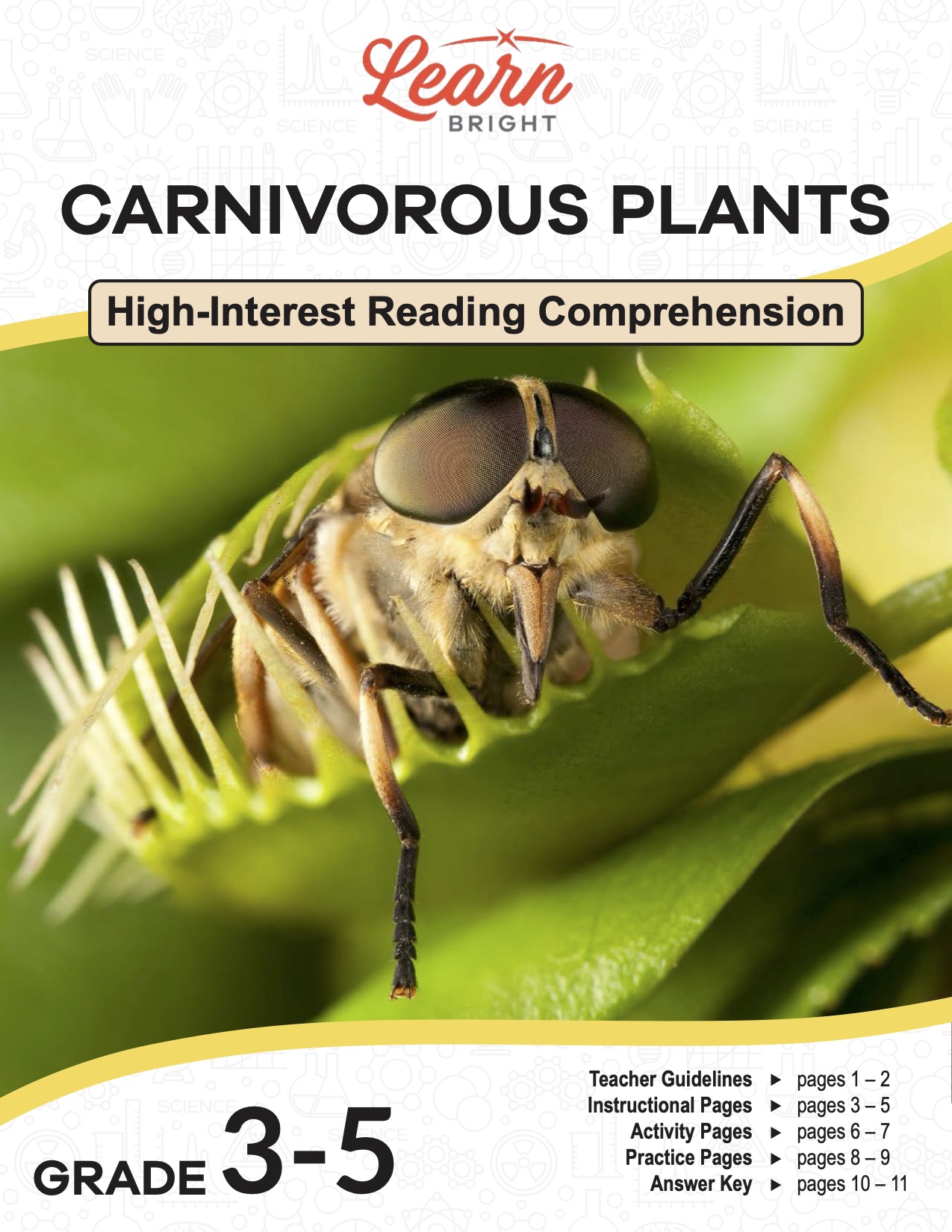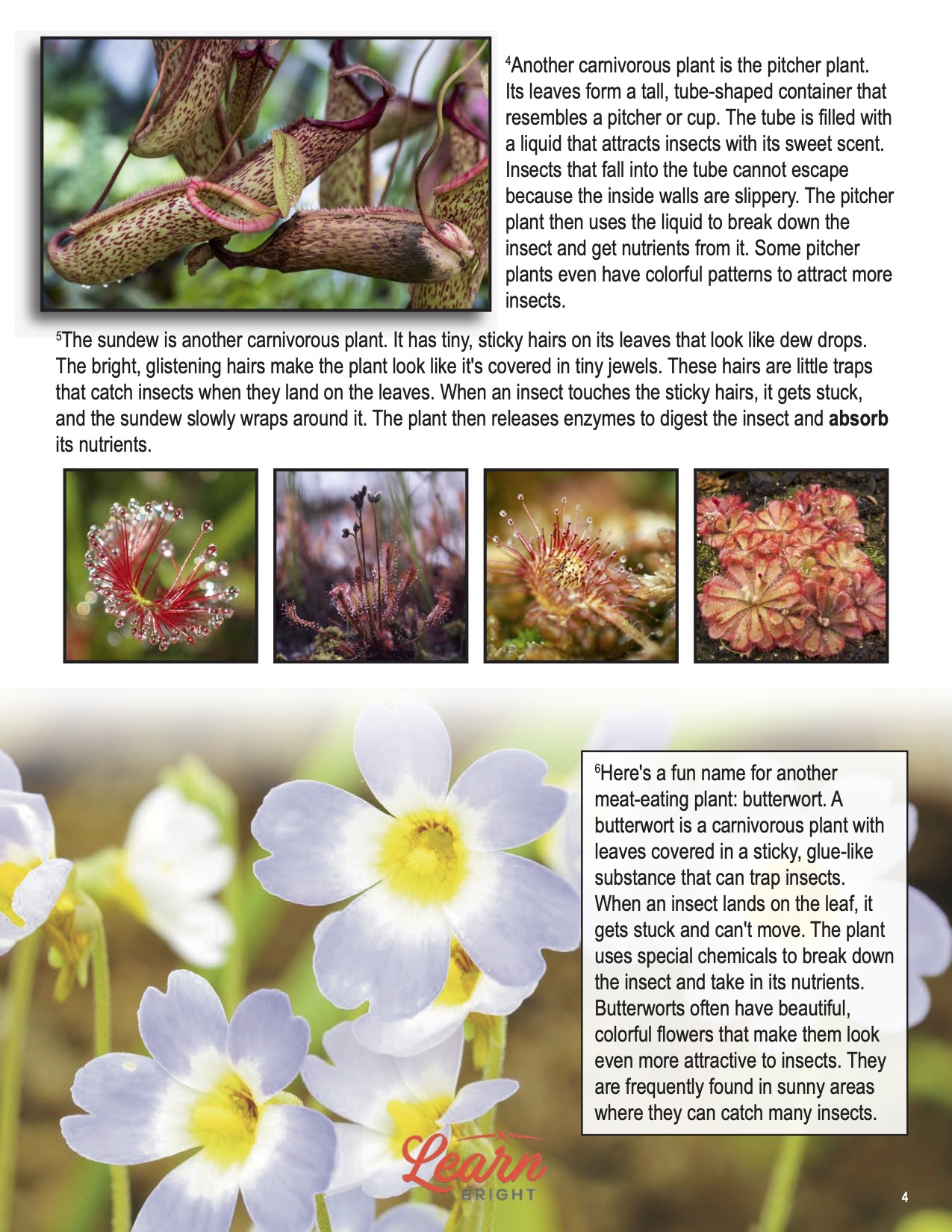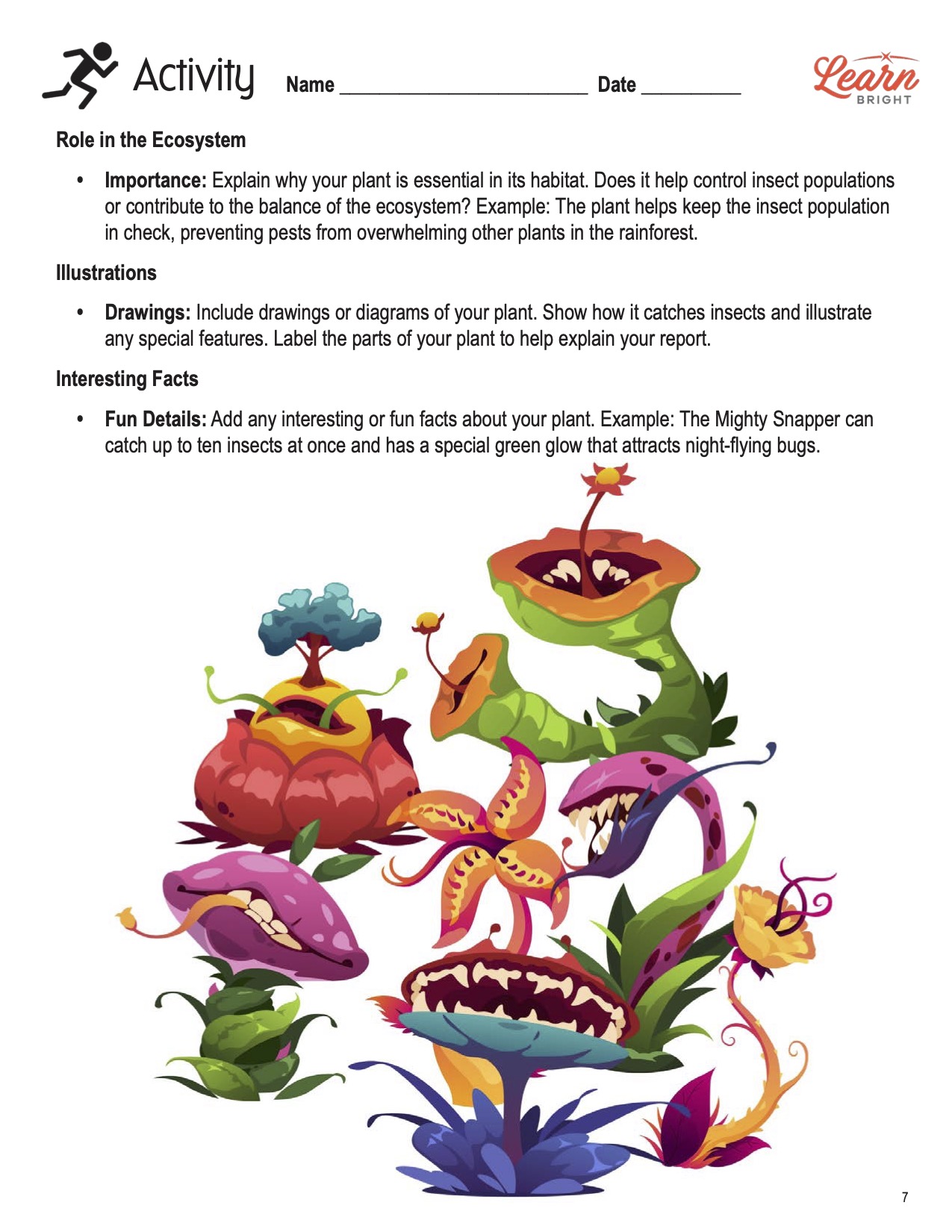Description
What our Carnivorous Plants lesson plan includes
Lesson Objectives and Overview: Carnivorous Plants is a high-interest reading comprehension lesson plan. As such, students will practice various close reading and comprehension skills. In addition, they will learn about the habitat, diet, and behaviors of several carnivorous plants. This lesson is for students in 3rd grade, 4th grade, and 5th grade.
Classroom Procedure
Every lesson plan provides you with a classroom procedure page that outlines a step-by-step guide to follow. You do not have to follow the guide exactly. The guide helps you organize the lesson and details when to hand out worksheets. It also lists information in the yellow box that you might find useful. You will find the lesson objectives, state standards, and number of class sessions the lesson should take to complete in this area. In addition, it describes the supplies you will need as well as what and how you need to prepare beforehand. The activity for this lesson requires pens, colored pencils, and a science journal or paper.
Teacher Notes
The paragraph on this page provides a little more information or guidance on what to expect from the lesson. It explains that you can teach this lesson in a whole-class setting or as an independent, small-group activity. You can use the blank lines to record any thoughts or ideas you have as you prepare.
CARNIVOROUS PLANTS LESSON PLAN CONTENT PAGES
What Are Carnivorous Plants?
The Carnivorous Plants lesson plan contains three content pages. Carnivorous plants are a unique group of plant species that eat insects, sometimes even small animals. These plants have interesting ways of catching their food. They live in places where the soil is poor in nutrients, so they have to find other ways to get the nutrients to grow and survive. By catching insects, they can get extra vitamins and minerals to develop properly.
These plants are found in different parts of the world. Some grow in swamps and bogs, where the soil is very wet and acidic. Others grow in tropical forests with high humidity. Each type of carnivorous plant has adapted to its environment in its own way. Their ability to eat animals helps them survive and thrive in their specific habitats.
Examples of Carnivorous Plants
Venus Flytrap and Pitcher Plant
One famous carnivorous plant is the Venus flytrap. Its leaves are basically jaws that look like clam shells, complete with tiny teeth along the edges. When an insect lands on the leaf, these “jaws” snap shut very quickly, like a trap. In fact, it can snap shut in less than a second, trapping the insect inside. The plant then digests the insect inside its jaws, using special enzymes to break it down. Each leaf can only do this a few times before the it dies, so the Venus flytrap needs to catch enough food to stay healthy.
Another carnivorous plant is the pitcher plant. Its leaves form a tall, tube-shaped container that resembles a pitcher or cup. The tube is filled with a liquid that attracts insects with its sweet scent. Insects that fall into the tube cannot escape because the inside walls are slippery. The pitcher plant then uses the liquid to break down the insect and get nutrients from it. Some pitcher plants even have colorful patterns to attract more insects.
Sundew and Butterwort
The sundew is another carnivorous plant. It has tiny, sticky hairs on its leaves that look like dew drops. The bright, glistening hairs make the plant look like it’s covered in tiny jewels. These hairs are little traps that catch insects when they land on the leaves. When an insect touches the sticky hairs, it gets stuck, and the sundew slowly wraps around it. The plant then releases enzymes to digest the insect and absorb its nutrients.
Here’s a fun name for another meat-eating plant: butterwort. A butterwort is a carnivorous plant with leaves covered in a sticky, glue-like substance that can trap insects. When an insect lands on the leaf, it gets stuck and can’t move. The plant uses special chemicals to break down the insect and take in its nutrients. Butterworts often have beautiful, colorful flowers that make them look even more attractive to insects. They are frequently found in sunny areas where they can catch many insects.
Diet
All these plants have different ways of catching their food, but they have one thing in common: they need extra nutrients to grow. They live where the soil does not have enough food for them. That’s why they catch and eat insects instead of relying on the soil. When they consume insects, they get the essential nutrients that their soil lacks. This unique method of obtaining nutrients helps them thrive in challenging conditions.
Why They Are Important
Carnivorous plants are not harmful to people. They only eat small insects and do not pose any danger to humans. In fact, they can help gardeners by keeping bugs away from other plants. They are also stunning and interesting, with their distinctive shapes and colors. So, people can enjoy quite a few benefits by putting these kinds of plant species in their gardens or greenhouses.
Sadly, some carnivorous plants are in danger of disappearing. Their homes are being damaged by things like buildings and pollution. The Venus flytrap, which only grows in a few places in the Carolinas, is at risk because its home is being taken over. Pitcher plants live in wetlands and are also threatened because their wetland homes are being drained or changed.
Sundews, which grow in bogs, face problems from habitat destruction and climate change. People are working hard to protect these plants by caring for their homes and growing them in special gardens. We can help them as well by learning about them and supporting efforts to keep their homes safe.
CARNIVOROUS PLANTS LESSON PLAN WORKSHEETS
The Carnivorous Plants lesson plan includes two worksheets: an activity worksheet and a practice worksheet. Each one will help students solidify their grasp of the material they learned throughout the lesson. You can refer to the classroom procedure guidelines to know when to hand out each worksheet.
FLORA EXPLORER ACTIVITY WORKSHEET
This interesting activity requires students to pretend to be a botanist that has discovered a new carnivorous plant. Students will write a scientific report about this fantastic new plant. They will follow the instructions to include various parts of their report, such as introduction, habitat information, feeding process, and illustrations.
CARNIVOROUS PLANTS REVIEW PRACTICE WORKSHEET
The practice worksheet requires students to answer a series of 10 questions. These questions all relate to the content pages, so students will need to refer to them often for the answers. In addition, each question provides which reading tool the question corresponds to, such as text feature, vocabulary, or comprehension.
Worksheet Answer Keys
At the end of the lesson plan document is an answer key for the practice worksheet. The correct answers are all in red to make it easier for you to compare them with students’ responses. If you choose to administer the lesson pages to your students via PDF, you will need to save a new file that omits these pages. Otherwise, you can simply print out the applicable pages and keep these as reference for yourself when grading assignments.









